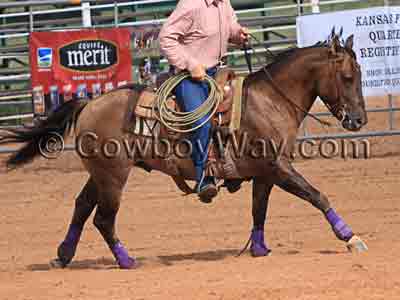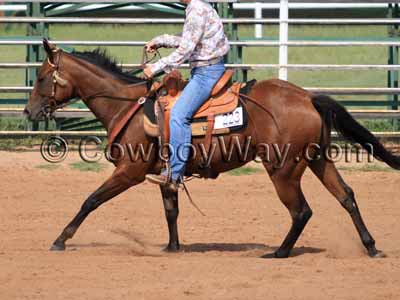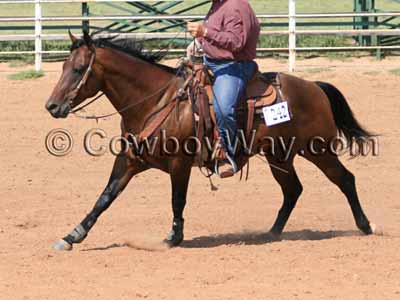What Are Horse Leads?
When a horse is loping or galloping the legs on one side of its body lead, or reach forward farther than the legs on the other side.
In a left lead a loping or galloping horse will reach the left hind leg and the left front leg farther forward than the right legs.
For a right lead, the opposite is true: The legs on the right side of the horse's body will reach forward farther during a lope or gallop than the legs on the left side.
It is important to note that leads are unique to the gaits of lope (also called a canter) and gallop. During other gaits (walk, trot, and others) a horse moves its legs differently than it does during a lope or gallop and the concept of leads does not apply.
Right Lead
During a lope in a right lead, a horse moves its legs in the following order:
- The horse begins by pushing off with the left hind leg.
- Then, in unison, it moves the right hind leg and the left front leg
forward.
(This is sometimes called the "opposite diagonal pair.") - Lastly, the horse moves the right front leg forward.
Below: A horse loping in a circle to the right on a right lead.

The horse will keep repeating this sequence of leg movements until it stops, changes gaits, or changes leads.
The sequence of leg movements for a gallop in a right lead is very similar the sequence above. However, at a gallop a horse will not move its legs in unison as described in step number 2. Instead, it will move its right hind leg forward followed by the left front leg, instead of moving them at the same time.
In a right lead, the right hind leg and right front leg will reach farther forward than the legs on the left side of the horse's body. This distinction can be easily seen, and can also be felt by many riders.
Left Lead
During a lope in a left lead, a horse moves its legs in the following order:
- The horse begins by pushing off with the right hind leg.
- Then, in unison, it moves the left hind leg and the right front leg
forward.
(This is sometimes called the "opposite diagonal pair.") - Lastly, the horse moves the left front leg forward.
Below: A horse loping in a circle to the left on a left lead.

The horse will keep repeating this sequence of leg movements until it stops, changes gaits, or changes leads.
The sequence of leg movements for a gallop in a left lead is very similar the sequence above. However, at a gallop a horse will not move its legs in unison as described in step number 2. Instead, it will move its left hind leg forward followed by the right front leg, instead of moving them at the same time.
In a left lead, the left hind leg and left front leg will reach farther forward than the legs on the right side of the horse's body. This distinction can be easily seen, and can also be felt by many riders.
Right Lead, Wrong Lead / Inside and Out
When a horse is loping or galloping there are times where using one lead or the other will be considered correct or incorrect.
For example, when a horse is loping or galloping in a bend or a circle it will be more athletic when it is using the lead on the inside of the bend or circle. Therefore, in most cases, an "inside" lead will be considered the correct lead and an "outside" lead will be considered incorrect.
So, if a horse is loping or galloping while bending or circling to the left, a left lead will be the inside lead and will usually be considered the correct lead.
Conversely, when a horse is loping or galloping while bending or circling to the right, a right lead will be the inside lead and will typically be thought of as the correct lead.
Below: A horse loping in a circle to the left on a right, or outside, lead. While this is sometimes done intentionally, it is often a mistake.

Advertisement - Western Star, Rope Trim Metal Wastebasket / From Amazon

Leads, Schmeads, It May Not Even Matter
Just knowing that a horse has leads doesn't mean a rider will always care which one a horse uses.
Although riders can and do cue their horses to use a right or left lead, there are many times when a rider simply lets the horse choose. As horses become experienced at carrying riders they become very adept at choosing their leads for themselves. If circumstances change horses can change leads between strides, a maneuver called a "flying lead change."
At times, however, a rider might feel it's best to tell the horse which lead to use.
For example, a barrel racer will know going into the arena which barrel they plan on turning first, so they will probably make sure the horse begins the barrel race on a right lead (for turning the right barrel first) or a left lead (for turning the left barrel first.). You can see this page for information and illustrations about the cloverleaf barrel racing pattern.
Another example would be a competitor in a reining horse competition who knows the reining pattern they are about to perform: They will try to make sure the horse takes the correct (inside) lead when beginning circles during the reining pattern.
Remember, a horse only has leads during the gaits of lope (also called a canter) and gallop. During other gaits there is no such thing as a lead.
Also, leads usually only make a difference in a horse's ability to be athletic or move well if a horse is bending or turning. If a horse is loping or galloping in a straight line it usually doesn't make any difference which lead it is on unless the rider happens to have a preference.
Left Leads Preferred
Just as most people are right-handed, most horses are left-sided.
This means most horses are naturally more athletic when performing maneuvers to their left. This, in turn, means that most horses will prefer to use a left lead over a right one.
In the competitive world, the left-sided preference of most horses can sometimes be easily seen. In barrel racing, for example, you may have noticed that most barrel racers choose to turn the right barrel first so that their horse will have one right-hand turn (the first barrel), and two left-hand turns (the second and third barrels).
For events such as tie-down roping and team roping, most arenas place the roping boxes toward the right-hand side of the arena. This is so that roping horses have more room to work in the arena moving toward the left, their (usually) preferred side.
The natural tendency of horses preferring to work toward one side (usually the left one) can typically be overcome. In training, during other riding, or in round-pen work it is not uncommon for a horse to be asked to practice more in the direction of their less-preferred side. Patient practice can help a horse learn to work well in both directions.
Lead Language
Counter Canter - A counter canter is when a horse is asked to canter (also called a lope) in a bend or a circle on the outside lead (remember, horses are usually asked to use their inside leads). A counter canter is an intentional maneuver, and is not considered a mistake when asked for by the rider.
Cross Fire (aka Cross Canter) - When a horse cross fires it means they are loping or galloping on one lead with the front legs, and the opposite lead on the back legs. A cross fire is an incorrect movement. To confuse things a bit, the term "cross fire" is also used to describe a horse that strikes one of its own legs against another, and the term is also used in team roping to describe a heeler that throws his or her loop before the rules allow.
Flying Lead Change (aka Flying Change) - When loping or galloping a flying lead change is when a horse changes from one lead to another in mid-air between strides.
What Is / Are...
… What Are 5 Of The Biggest Wild West Robberies?
… What Are 5 Reasons Horse Trailer Lighting Matters?
… What Are 8 Dumb Things To Say To A Horse Lover?
… What Are 9 Proven Ways To Keep Flies Off Horses?
… What Are Chestnuts and Ergots?
… What Are The Parts Of A Western Saddle?
… What Are Saddle Rigging Positions?
… What Are Some Fencing Options?
… What Are Some Foods Both Horses And Dogs Can Eat?
… What Are Some Horse Fencing Basics?
… What Are Some Interesting Horse Facts?
… What Are Some Interesting Charts and Graphs With Horse Information?
… What Are Some Options For Temporary Horse Fencing?
… What Are Synthetic Saddles Made Of?
… What Are The Rodeo Catch Pens?
… What Are The 10 Best 3-Horse Trailers With Living Quarters In The USA And Canada?
… What Are The X's In A Cowboy Hat?
… What Are The Three Legal Head Catches?
… What Is The Angle System For Branding?
… What Is The Barrel Racing Pattern?
… What Is A Bull Riding Vest Made Of?
… What Is Deworming Your Horse?
… What Is A Domain Name?
Why would I need one for my farm or ranch even if I don't have or
want a website?
… What Is A Fifth Wheel Trailer Hitch?
… What Is Flag and National Anthem Etiquette At A Rodeo?
… What Is A Slant Load Horse Trailer?
… What Is Floating A Horse's Teeth?
… What Do Horse Freeze Brands Look Like?
… What Is A Galvayne's Groove?
… What Is A Gooseneck Trailer Hitch?
… What Is Some History About The First National Finals Rodeo?
… What Is The History Of The Modern, Hornless, Bronc Riding Saddle?
… What Is The History Of The Modern Rodeo Bucking Chute?
… What Is The History Of The One-Hand Bareback Rigging?
… What Is The Nasolacrimal Duct In Horses?
… What Is A Pony Express Mochila?
… What Is Hermann Oak Leather?
… What Is Larvicidal De-Worming?
… What Is The Flehmen Response?
… What Is The Rodeo Return Gate?
… What Is A Safety Tip For Posting The Colors?
… What Is A Slick Fork Saddle?
… What Is A Swell Fork Saddle?
You Might Also Like
